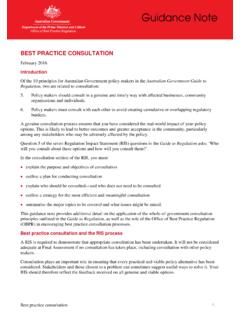Transcription of The Future Homes Standard - GOV.UK
1 October 2019 Ministry of Housing, Communities and local Government The Future Homes Standard 2019 consultation on changes to Part L (conservation of fuel and power) and Part F (ventilation) of the Building Regulations for new dwellings Crown copyright, 2019 Copyright in the typographical arrangement rests with the Crown. You may re-use this information (not including logos) free of charge in any format or medium, under the terms of the Open Government Licence. To view this licence visit This document/publication is also available on our website at If you have any enquiries regarding this document/publication, complete the form at or write to us at: Ministry of Housing, Communities and local Government Fry Building 2 Marsham Street London SW1P 4DF Telephone: 030 3444 0000 For all our latest news and updates follow us on Twitter.
2 October 2019 3 Contents Scope of the consultation 6 Chapter 1 Introduction 10 The consultation Package 11 Package Contents 12 Development of these proposals 14 Further Consideration 14 Timetable for introduction of changes 15 Chapter 2 The Future Homes Standard 16 Background 16 What should the Future Homes Standard look like? 17 Implementing the Future Homes Standard 20 Certainty and consistency in setting energy efficiency standards 21 Roadmap to the Future Homes Standard 22 Chapter 3 Part L standards for New Homes in 2020 24 Background 24 Uplift of the Part L minimum Standard 25 Performance metrics 26 Calculating the primary energy rate and emission rate 34 Guidance 38 Energy Performance of Buildings Directive 42 Chapter 4 Part F Changes 44 4 Background 44 Performance based ventilation standards 45 Minimising the ingress of external pollutants 46
3 Noise 46 Ventilation Solutions for Dwellings 47 Simplification of Design Guidance 49 Chapter 5 Airtightness 52 Background 52 Encouraging appropriate levels of airtightness 52 Accounting for uncertainty in airtightness test results 53 Introducing an alternative to the blower door test 54 Revising the approved methodology 55 Chapter 6 Compliance, Performance and Providing Information 56 Background 56 Proposed measures to improve compliance and performance 57 Chapter 7 Transitional Arrangements 64 Background 64 Transitional arrangements for 2020 uplifts 64 Transitional Arrangements for the 2025 Future Homes Standard 65 Chapter 8 Feedback on the Impact Assessment 67 About this consultation 68 Annex A Privacy Notice 69 5 Annex B Changes to BR 443 71 Annex C Build Quality 73 Annex D BREL Compliance Report 77 Annex E consultation Questions 80 6 Scope of the
4 consultation Topic of this consultation : The 2019 Spring Statement includes a commitment that, by 2025, we will introduce a Future Homes Standard for new build Homes to be Future -proofed with low carbon heating and world-leading levels of energy efficiency. Energy efficiency requirements for new Homes are set by Part L (Conservation of Fuel and Power) and Part 6 of the Building Regulations. This consultation sets out our plans for achieving the Future Homes Standard , including proposed options to increase the energy efficiency requirements for new Homes in 2020 as a meaningful and achievable stepping stone to the Future Homes Standard .
5 This consultation is the first stage of a two-part consultation about proposed changes to building regulations. It also covers the wider impacts of Part L for new Homes , including changes to Part F (Ventilation), its associated Approved Document guidance, airtightness and improving as built performance of the constructed home . Scope of this consultation : The UK has set in law a target to bring all its greenhouse gas emissions to net zero by 2050 one of the most ambitious targets in the world.
6 Homes both new and existing account for 20% of emissions. Despite progress reducing emissions from Homes , we need to go much further. New Homes being built now and in the next 5-10 years will still exist in 2050 and therefore we must ensure that the energy efficiency standards we set for them put us on track to meet the 2050 target. As part of the journey to 2050 we have committed to introducing the Future Homes Standard in 2025. This consultation sets out what we think a home built to the Future Homes Standard will be like.
7 We expect that an average home built to it will have 75-80% less carbon emissions than one built to current energy efficiency requirements (Approved Document L 2013). We expect this will be achieved through very high fabric standards and a low carbon heating system. This means a new home built to the Future Homes Standard might have a heat pump, triple glazing and standards for walls, floors and roofs that significantly limit any heat loss. We need to help the industry reach a position where it can deliver in 2025.
8 We propose introducing in 2020 a meaningful but achievable uplift to energy efficiency standards as a stepping stone to the Future Homes Standard . The intention is to make new Homes more energy efficient and to Future -proof them in readiness for low carbon heating systems. 7 We expect to launch a further consultation in the coming months addressing existing domestic buildings, and new and existing non-domestic buildings. This initial consultation relates to new domestic buildings; and includes changes to Part F (Ventilation).
9 The initial consultation addresses: options to uplift standards for Part L of the Building Regulations in 2020; and changes to Part F more stringent transitional arrangements for these standards to encourage quicker implementation draft outline specification for Future consultation about the Future Homes Standard clarifying the role of planning authorities in setting energy efficiency standards . The consultation sets out two options to uplift energy efficiency standards and requirements: Option 1: 20% reduction in carbon emissions compared to the current Standard for an average home .
10 We anticipate this could be delivered by very high fabric standards (typically with triple glazing and minimal heat loss from walls, ceilings and roofs). Option 2: 31% reduction in carbon emissions compared to the current Standard . We anticipate this could be delivered based on the installation of carbon-saving technology such as photovoltaic (solar) panels and better fabric standards , though not as high as in option 1 (typically double not triple glazing). Option 2 is our preferred option.


















